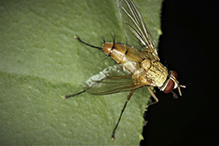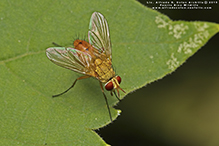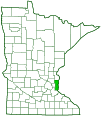tachinid fly
(Leskia similis)
Conservation • Description • Habitat • Ecology • Distribution • Taxonomy
Conservation Status |
|||
| IUCN Red List | not listed |
||
| NatureServe | not listed |
||
| Minnesota | not listed |
||
Description |
There are 41 species of Leskia worldwide. There are 3 species in North America north of Mexico, one in the west, two in the east. Only Leskia similis occurs in Minnesota. Leskia similis is an uncommon, small, yellow, tachinid fly. The face is convex when viewed from the side, at least on the lower half. The eyes are bare, not covered with hairs (setae). The front plate on the underside of the thorax (prosternum) is bare, having no setae. The small plate between the thorax and abdomen (scutellum) has two pairs of long bristles, the forward pair (nearest the head) convergent, the rear pair divergent. The abdomen is no more than two times as long as wide. It is broadly connected to the thorax, not constricted at the base. The wings are clear. The small membranous lobe at the base of the forewing that covers the haltere (calypter) is well developed. The fourth segment (tibia) on the middle leg has just one bristle on the upperside before the tip (anterodorsal). |
Size |
|
Similar Species |
Habitat |
|
Ecology |
Season |
|
Behavior |
|
Life Cycle |
|
Food |
|
Distribution |
||
|
Sources |
|
| 9/8/2025 | ||
Occurrence |
||
|
||
Taxonomy |
|
Order |
|
Suborder |
Brachycera |
Infraorder |
Cyclorrhapha |
Zoosection |
Schizophora |
Zoosubsection |
|
Superfamily |
Oestroidea (Bot Flies, Blow Flies, and Allies) |
Family |
|
Subfamily |
Tachininae |
Tribe |
Leskiini |
Genus |
Leskia |
Subordinate Taxa |
|
|
|
Synonyms |
|
Myobiopsis similis Stomoxys pallida |
|
Common Names |
|
This species has no common name. The common name for the family Tachinidae is tachinid flies, and it is applied here for convenience. |
|
Glossary
Calypter
On flies: one of two small membranous lobes at the base of the forewing that covers the haltere.
Halteres
In flies: a pair of knob-like structures on the thorax representing hind wings that are used for balance.
Scutellum
The exoskeletal plate covering the rearward (posterior) part of the middle segment of the thorax in some insects. In Coleoptera, Hemiptera, and Homoptera, the dorsal, often triangular plate behind the pronotum and between the bases of the front wings. In Diptera, the exoskeletal plate between the abdomen and the thorax.
Seta
A stiff, hair-like process on the outer surface of an organism. In Lepidoptera: A usually rigid bristle- or hair-like outgrowth used to sense touch. In mosses: The stalk supporting a spore-bearing capsule and supplying it with nutrients. Plural: setae. Adjective: setose.
Tibia
The fourth segment of an insect leg, after the femur and before the tarsus (foot). The fifth segment of a spider leg or palp. Plural: tibiae.
Visitor Photos
Share your photo of this insect.
This button not working for you?
Simply email us at info@MinnesotaSeasons.com.
Attach one or more photos and, if you like, a caption.
Alfredo Colon |
||
 |
 |
|
MinnesotaSeasons.com Photos
|

Slideshows

Visitor Videos
Share your video of this insect.
This button not working for you?
Simply email us at info@MinnesotaSeasons.com.
Attach a video, a YouTube link, or a cloud storage link.
Other Videos




